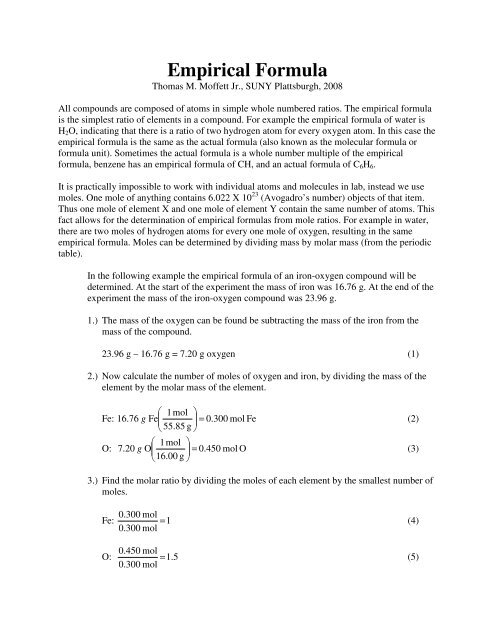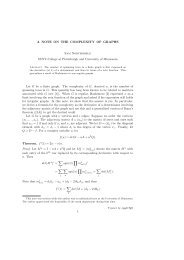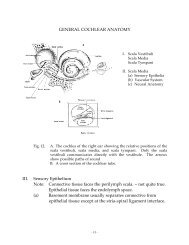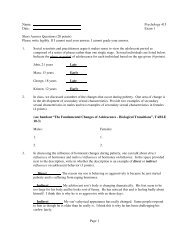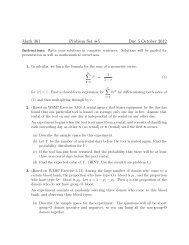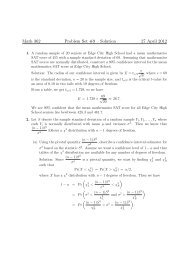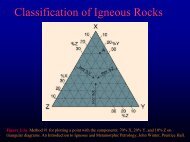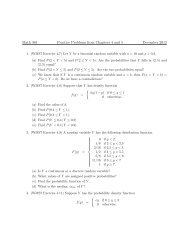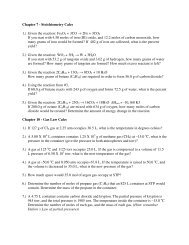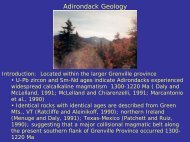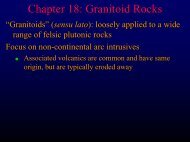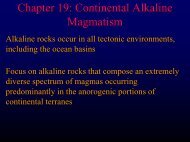Empirical Formula - Faculty web pages - SUNY Plattsburgh
Empirical Formula - Faculty web pages - SUNY Plattsburgh
Empirical Formula - Faculty web pages - SUNY Plattsburgh
- No tags were found...
You also want an ePaper? Increase the reach of your titles
YUMPU automatically turns print PDFs into web optimized ePapers that Google loves.
<strong>Empirical</strong> <strong>Formula</strong>Thomas M. Moffett Jr., <strong>SUNY</strong> <strong>Plattsburgh</strong>, 2008All compounds are composed of atoms in simple whole numbered ratios. The empirical formulais the simplest ratio of elements in a compound. For example the empirical formula of water isH 2 O, indicating that there is a ratio of two hydrogen atom for every oxygen atom. In this case theempirical formula is the same as the actual formula (also known as the molecular formula orformula unit). Sometimes the actual formula is a whole number multiple of the empiricalformula, benzene has an empirical formula of CH, and an actual formula of C 6 H 6 .It is practically impossible to work with individual atoms and molecules in lab, instead we usemoles. One mole of anything contains 6.022 X 10 23 (Avogadro’s number) objects of that item.Thus one mole of element X and one mole of element Y contain the same number of atoms. Thisfact allows for the determination of empirical formulas from mole ratios. For example in water,there are two moles of hydrogen atoms for every one mole of oxygen, resulting in the sameempirical formula. Moles can be determined by dividing mass by molar mass (from the periodictable).In the following example the empirical formula of an iron-oxygen compound will bedetermined. At the start of the experiment the mass of iron was 16.76 g. At the end of theexperiment the mass of the iron-oxygen compound was 23.96 g.1.) The mass of the oxygen can be found be subtracting the mass of the iron from themass of the compound.23.96 g – 16.76 g = 7.20 g oxygen (1)2.) Now calculate the number of moles of oxygen and iron, by dividing the mass of theelement by the molar mass of the element. 1mol Fe: 16 .76 g Fe = 0.300 mol Fe 55.85 g (2) 1mol O: 7 .20 g O = 0.450 mol O16.00 g (3)3.) Find the molar ratio by dividing the moles of each element by the smallest number ofmoles.0.300 molFe: = 1(4)0.300 mol0.450 molO: = 1.5(5)0.300 mol
4.) The ratio becomes the subscripts in the empirical formula. Since a chemical formulacan’t have a fraction for a subscript (O 1.5 ), the molar ratio needs to be multiplied by afactor to remove the fraction.Fe: 1 X 2 = 2 (6)O: 1.5 X 2 = 3 (7)5.) Now that the fraction has been eliminated, the empirical formula can be written.<strong>Empirical</strong> <strong>Formula</strong> = Fe 2 O 3In order to determine the actual formula, the molar mass of the compound must be known. Todetermine the actual formula, first determine the mass of one mole of the empirical formula(empirical mass). If the empirical mass is the same as the molar mass, then the empirical formulais the actual formula. If they are not the same, then the actual formula is a multiple of theempirical formula.In the next example, the molecular formula of acetic acid will be determined. Theempirical formula of acetic acid is CH 2 O and the molar mass of acetic acid is 60.0 g/mol.1.) Determine the empirical mass of acetic acid.C: 1 (12.0g) = 12.0 gH: 2(1.01g) = 2.02 gO: 1(16.0g) = 16.0 g (8)CH 2 O = 30.0 g/mol (empirical mass)2.) Divide the molar mass by the empirical mass to determine the factor that thesubscripts need to be multiplied by to write the actual formula.molar massempirical mass60.0 g/mol= = 2(9)30.0 g/molThe actual formula is therefore C 2 H 4 O 2In this experiment you will determine the empirical formula of a compound formed bymagnesium and oxygen. The reaction occurs between magnesium metal and oxygen in the air.The reaction will be run at high temperature (using a Bunsen burner flame) in order to speed upthe rate of reaction. Unfortunately magnesium will also react with nitrogen at high temperaturesforming a magnesium-nitrogen compound. This compound can be converted to the magnesiumoxygencompound by heating in the presence of water.
Procedure 1 :Your instructor will review how to operate a Bunsen burner.Caution a hot crucible looks the same as a cool crucible.When weighing your crucible make sure that it has reached room temperature. If you weigh awarm object, the temperature difference will create air currents around the balance and give youin incorrect mass.1.) Wash rinse and dry your crucible and cover. The crucible may have a dark stain that can’t beremoved, this is ok.2.) Place the crucible in a clay triangle. The bottom of the crucible should be approximately 5cm above the top of the Bunsen burner. Heat the crucible with the hottest part of the flamefor two minutes. This will serve to further clean out the crucible. After two minutes, turn offthe burner and allow the crucible to cool. When it has reached room temperature determinethe mass of the crucible.3.) Add approximately 0.5 g of magnesium turnings or magnesium powder to the crucible.Record the exact mass of the crucible and magnesium.4.) Cover the crucible and heat it gently for several minutes. Heat with the full flame for 15minutes.5.) Let the crucible cool for five minutes, and then adjust the cover so that there is a smallopening.6.) Heat the crucible with the full flame again. During this time periodically check the contentsof the crucible by lifting the cover. If the contents glow brightly or emit white smoke then thereaction is not yet complete. Continue with this heating until all of the magnesium hasreacted.7.) Cool the crucible to room temperature. Add 10 to 15 drops of deionized water. Replace thecover so that there is a small opening and heat the crucible with a low flame for five minutes.8.) Cool the crucible to room temperature. Determine the mass of the crucible and magnesiumoxygencompound.9.) The compound may be scraped into the trash when you are finished with the experiment.10.) Repeat the procedure1 Adapted from Dickson, T.R. Laboratory Experiments to Accompany Introduction to Chemistry, 8 th ed., New York:John Wiley & Sons Inc., 2000.
Sample Data SheetMass of crucible and magnesiumMass of crucibleMass of magnesiumMass of crucible and magnesium-oxygen compoundMass of magnesium-oxygen compoundMass of oxygen<strong>Empirical</strong> <strong>Formula</strong>___________ ______________________ ______________________ ______________________ ______________________ ______________________ ______________________ ___________Post Lab Questions1.) For each of the following procedural errors indicate whether the mass of the compoundwould have been too big or too small. Explain your answer.a.) A student forgot to put the cover on the crucible, when it was heated some of the contentscame flying out of the crucible.b.) A student closed the air vent all the way on the Bunsen burner, creating a dirty yellowflame which deposited soot on the crucible.2.) Determine the empirical formula of calcium phosphide which is comprised of 66.00 %calcium and 34.00 % phosphorous.3.) Glucose has a molar mass of 180.1 g/mol and is comprised of 40.0 % carbon, 6.72 %hydrogen, and 53.3 % oxygen. Determine the molecular formula of glucose.4.) Determine the molecular formula of octane, which has a molar mass of 114.26 g/mol. A245 g sample contains 206.0 g of carbon, the remainder is hydrogen.Pre Lab Questions1.) Why is water added to the reaction mixture towards the end of the procedure?2.) What should you use to extinguish a magnesium fire?3.) A student determined that the mass of a magnesium ribbon was 0.380 g, how many moles isthis?4.) Determine the number of magnesium atoms in the 0.380 g ribbon.5.) Determine the mass of 3.25 X 10 22 oxygen atoms.


